Building Hoist For Passenger’s Material ( Outdoor Elevators)
A building hoist, also known as an outdoor elevator or construction lift, is a vertical transportation system that is used to move passengers and materials between different floors of a building or construction site. Building hoists are typically used in high-rise construction projects where it is not practical or safe to use traditional construction equipment such as cranes or scaffolding.
Ourbuilding hoists consist of a steel frame structure, a platform or cabin, a hoisting mechanism, and safety devices. The steel frame is typically mounted on the exterior of the building and consists of vertical and horizontal beams that support the hoist’s platform or cabin. The platform or cabin is usually made of steel and can accommodate both passengers and materials. The hoisting mechanism includes an electric motor, a gearbox, and wire ropes that are attached to the platform or cabin. The safety devices include overload sensors, emergency stop buttons, and safety brakes.
Our building hoists can be operated manually or automatically. In manual mode, an operator controls the hoist from a control panel located on the platform or cabin. In automatic mode, the hoist is controlled by a computer that is programmed to move the platform or cabin to different floors based on predetermined instructions.
There are several types of building hoists, including single-cage hoists, twin-cage hoists, and traction hoists. Single-cage hoists are the most basic type of building hoist and consist of a single platform or cabin that is used to transport both passengers and materials. Twin-cage hoists, on the other hand, have two separate cages that are used to transport passengers and materials separately. Traction hoists use a motor-driven drum to wind the wire ropes that are attached to the platform or cabin.
Building hoists manufactured by Jayem offer several advantages over traditional construction equipment such as cranes or scaffolding. For one, building hoists are much faster and more efficient at moving passengers and materials between different floors. They also offer a higher level of safety since passengers and materials are enclosed within the platform or cabin and are protected by safety devices such as emergency stop buttons and safety brakes. Additionally, our building hoists require less space and are easier to install and dismantle than traditional construction equipment.
However, building hoists also have some disadvantages that need to be taken into consideration. For one, building hoists can be expensive to purchase and maintain. They also require a significant amount of power to operate, which can add to construction costs. Finally, building hoists can be noisy and can cause disruptions to nearby residents.
In conclusion, building hoists are an important vertical transportation system that is used to move passengers and materials between different floors of a building or construction site. They offer several advantages over traditional construction equipment such as cranes or scaffolding, but also have some disadvantages that need to be taken into consideration. Overall, Jayem building hoists are a valuable tool for any construction project that requires vertical transportation.

DESCRIPTION
Table : Single Cage Standard Speed
| Model | Speed m/Min | Capacity(Kgs) | Motor(kw) | Cabin Size ( LxWxH in M.) |
| SC-100 | 36 | 1000 | 1 x 11 kw | 2 x 1.2 x 2.2 |
| SC-150 | 36 | 1500 | 2 x 9.2 kw | 2.5 x 1.2 x 2.2 |
| SC-200 | 36 | 2000 | 3 x 9.2 kw | 3 x 1.2 x 2.2 |
| SC-300 | 36 | 3000 | 3 x 11 kw | 3.5 x 1.2 x 2.2 |
Table : Twin Cage Standard Speed
| Model | Speed m/Min | Capacity(Kgs) | Motor(kw) | Cabin Size ( LxWxH in M.) |
| SC-100 | 36 | 2 x 1000 | 2 x 1 x 11 kw | 2 x 1.2 x 2.2 |
| SC-150 | 36 | 2 x 1500 | 2 x 2 x 9.2 kw | 2.5 x 1.2 x 2.2 |
| SC-200 | 36 | 2 x 2000 | 2 x 3 x 9.2 kw | 3 x 1.2 x 2.2 |
| SC-300 | 36 | 2 x 3000 | 2 x 3 x 11 kw | 3.5 x 1.2 x 2.2 |
| Condition | New |
|---|---|
| Color | Yellow |




